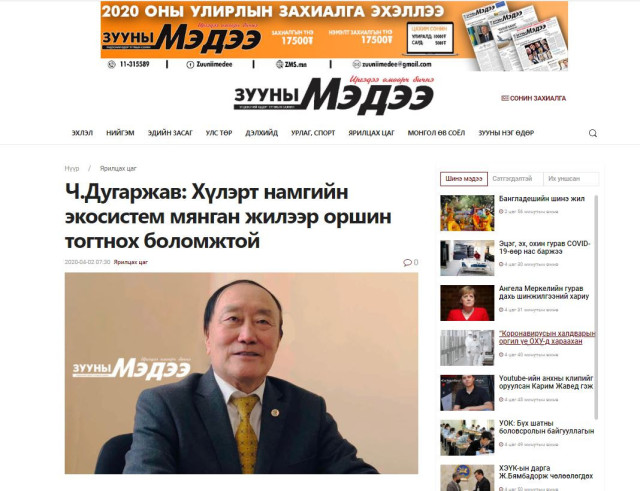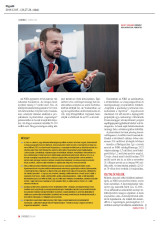Academician Ch. Dugarjav: Peatbogs ecosystems can survive for thousands of years. We are grateful to IIB for supporting this important environmental project.
Source: ЗУУНЫ МЭДЭЭ
Interview with Ch. Dugarjav, Academician of the Mongolian Academy of Sciences, PhD in Biological Science, Professor.
You are doing a research work related to peat bogs. Let us start our conversation on what exactly is a peat bog.
Many countries of the world practice widespread industrial use of peat. In countries with the largest peat reserves, such as Russia, Finland, Canada, and the United States, peat bogs are often being dried and then used for arable land and pastures. Peat is also extracted industrially, and used as fertilizer, fuel and thermal insulation materials.
As for Mongolia, peat cannot be used directly in our country. However, there is a practical experience of drying wetlands in wide valleys and river peat, turning them into arable land, using them for livestock grazing and harvesting hay. In conditions of constant excess water, moisture and swamp, semi-decomposed plant material accumulates and forms a thick layer of fluffy peat. In other words, there is a very close interaction between plants, peat and water. This interaction acts as a self-regulatory mechanism, allowing peat bog ecosystems to survive for thousands of years in various climate conditions.
Therefore, peat bogs are very importance for ecosystems. What does our country do to protect and properly use the peat bogs?
Peat bog ecosystems play a crucial role as they help to mitigate the climate change, provide water resources, protect permafrost from melting, absorb greenhouse gases, and conserve hydrocarbons and biodiversity. In addition, peat bogs are significant for the socio-economic development of a country. Nevertheless, global warming and human activities are the main reasons for the reduction of peat bogs. It is the same in our country.
Forest and steppe fires and logging can lead to peat burning, soil drying, permafrost melting, also degradation of wetland ecosystem leads to extinction of green species and increases the risk of pests’ spread.
Another negative factor is the large number of livestock. With the exception of winter livestock grazes on peat lands, also causing its degradation. Besides, the Yeruu, Bugant and Orkhon river basins are important industrial mining zones, so swamps and soils are being dug up while biological rehabilitation is not being carried out properly. Moreover, roads and railways construction also destroy peat bogs. When a road is built, the water is blocked, so the swamp at the bottom of the road dries up. If peat swamp “veins” are cut off, the peat dries out and vanishes, and, consequently, threatens the entire river ecosystems.
With the financial support from International Investment Bank (IIB) your institute is implementing a project related to peat bogs’ monitoring and protection in the main basin of the Tuul River. Could you please say a few words about it. How did you get financial support from the IIB?
In 1970, member countries jointly established International Investment Bank. The Bank's mission is to support the development, integration and cooperation between the economies of its member states in order to improve their competitiveness. The IIB member states are nine countries: Russia, Bulgaria, Hungary, Slovakia, Romania, the Czech Republic, Cuba, Mongolia and Vietnam. IIB provided more than 50 million Euros to support energy and food industry projects in Mongolia. In 2017 among the participants of an international scientific conference , I met the IIB representatives D. Molomjamts, PhD, and M.S. Minaeva, PhD, and we exchanged views on peat bogs problem in Mongolia, so I was advised to apply for IIB’s financial support. In November 2018, I and D. Regdel, the President of the Mongolian Academy of Science presented the project to Nikolay Kosov, the Chairperson of the IIB Management Board. As a result we signed a Memorandum of Understanding which provided for MNT 100 million worth financial support for our project. Thus, the project has started since then. Using this opportunity, I would like to express my deepest gratitude to the Chairperson Kosov and other members of the Management Board of the Bank.
What did you start your peat bog research and rehabilitating project in the basin of the Tuul River?
The Queen Tuul is a large river that flows through the Mongolian capital. In 1967, the Tuul River was flooded, and since then the flow has been declining, and in some springs, the water was cut off around the city. This heavily damaged the river basin. Trees were cut down, fires broke out, and pests multiplied. Many peat bogs were dried up for different reasons. Therefore, a research team was formed and in 2019 started its first expedition in the Gachuurt River basin. It carried out a comprehensive study of air and soil moisture temperature, peat content, water level and quality, plant species composition, growth, etc. in the the six closest and most forestless areas in the capital city area. In order to rehabilitate the swamp, they experimented with planting small dams and shrubs in the river. In addition, they arranged an intensive information campaign on the peat bogs importance addressed to the local communities. I would like to underline that this project also served as an important training platform for our young scientists studying peat bogs problems.
How do you see the results of the project?
IIB provided us with financial support for two years. This year, in addition to the previously conducted studies, we will make a research on groundwater levels, permafrost, and greenhouse gas emissions and absorption. Furthermore, we are planning to make also the socio-economic studies related to peat bot problematics. Rehabilitation of peat bogs will take a long time. In any case, the first results will appear in 5-10 years. Therefore, we will continue to conduct long-term ecological monitoring studies.
Is there a nationwide study on the distribution of peat bogs?
In the central and northern parts of Mongolia, peat bogs are mainly distributed in forested areas, especially taiga forests, the headwaters of large river valleys, flat tops of mountains, ridges, upper forests and watersheds. Peat bogs cover three percent of the world's land area. A 2004 study by the World Peat Swamp Initiative projected that peat bogs cover 1.7 percent of the country's territory. This is significantly lower in comparison with the results of studies conducted in the 1960s and 1970s. The Indonesian Sumatra and Kalimantan peat bogs have been formed over the last eleven thousand years, reaching peat depths of 25-30 meters. The average thickness of peat in Poland is two meters. The average thickness of peat in Uganda is 2-3 meters but in some places it reaches 20 meters. In the European part of Russia, the average layer of peat is 20-24 meters. The peat layer of peat bogs is 1.5 meters in Brazil and more than one meter in Peru. In the Mongolian territory of Yeruu soum, northwestern part of the Khentii mountain range, there is a six thousand year old 3-3.5 meter thick peat in the swamp Nuur. The average layer of peat in our country is 0.5-1.0 meters.
How the peat bogs protection and rehabilitation is conducted in other countries?
There are few well known methods of protecting peat bogs at the international, national and local levels. Among these are fencing, decommissioning, re-wetting, and planting trees, shrubs, and herbaceous plants. There are also many other ways.
As for Mongolia, we should mostly focus our efforts on the developing of a strategic plan for the comprehensive protection of peat bogs, including the improvement of the legal framework, extensive training and convincing advocacy.


